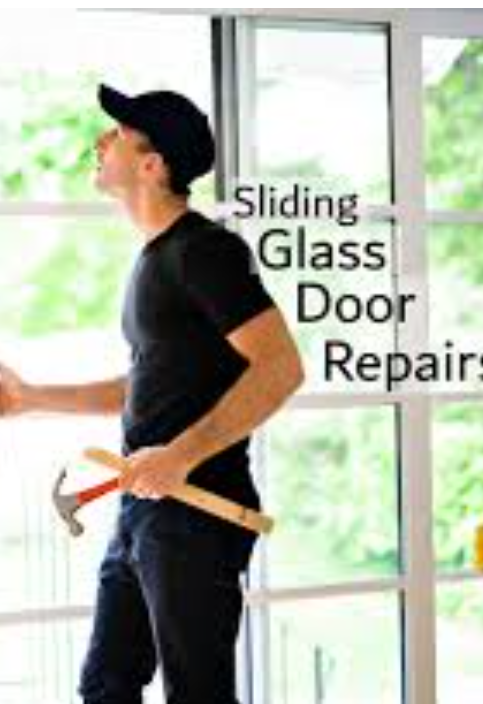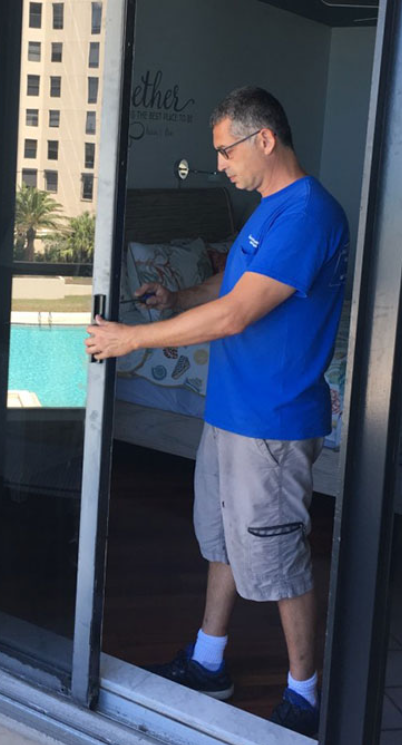Doors with sliding glass provide style and functionality to any home while making it simple to access outside areas and letting in lots of natural light. But these doors might develop problems with time, just like any mechanical part. We will lead you through the process of fixing typical moving glazing issues in this in-depth tutorial, allowing you to restore the smooth operation of the doors and increase their longevity.
Table of Contents
Understanding Sliding Glass Doors
Benefits of Sliding Glass Doors
Not only are swivel glass doors pleasing to the eye, but they also have several practical benefits. Your home will feel more open and connected to nature as a result of the seamless transition they provide between interior and outdoor areas. Additionally, by letting a lot of natural light into your home during the day, these doors could perhaps reduce the need for artificial lighting.
Components of a Sliding Glass Door System
A movable door with glass is made up of numerous essential parts that work together to ensure seamless operation. These consist of:
- Glass Panels: The large glass panels are the centerpiece of the door, providing visibility and aesthetic appeal.
- Rollers: These small wheels are attached to the bottom of the door panels, allowing them to glide along the tracks.
- Tracks: Tracks are channels that guide the rollers and ensure the door’s proper movement.
- Handles and Locks: Handles allow you to open and close the door, while locks ensure security.
Common Issues with Movable Glass Doors

Sticking or Jamming
Over time, dirt, debris, or misaligned tracks can cause your sliding glass door to stick or jam. This can be frustrating and may even pose a safety hazard. To address this issue, follow these steps:
- Clean the Tracks: Use a brush or vacuum cleaner to remove dirt and debris from the tracks.
- Lubricate the Tracks: Apply a silicone-based lubricant to the tracks to facilitate smooth movement.
Cracked or Broken Glass Panels
Accidents happen, and glass panels can crack or break. If you find yourself dealing with a damaged glass panel, here’s what you need to do:
- Safely Remove the Broken Glass: Wear gloves and eye protection, then carefully remove the broken glass from the frame.
- Prepare for Replacement: Clean the frame thoroughly and ensure it’s free of any glass shards.
- Install the New Glass Panel: Place the new glass panel into the frame and secure it using appropriate glazing techniques.
Worn Rollers and Tracks
The constant usage of the door causes regular wear and strain on the rollers and tracks. Consider doing the following actions if your moving glass door isn’t sliding as easily as it once did:
- Inspect the Rollers: Lift the door slightly to assess the condition of the rollers. If they appear worn or damaged, it’s time for a replacement.
- Remove and Replace Rollers: Carefully remove the old rollers and replace them with new ones. This may require removing the door from its frame temporarily.
- Check the Tracks: Examine the tracks for any signs of damage or obstruction. Clean them thoroughly to ensure unobstructed movement.
Faulty Handles and Locks
Handles and locks are crucial for both convenience and security. If your door’s handles or locks are malfunctioning, here’s what you can do:
- Disassemble the Handle Mechanism: Carefully remove the handle according to the manufacturer’s instructions.
- Identify the Issue: Inspect the components to identify the specific problem. It could be a loose screw, a worn-out part, or a misalignment.
- Repair or Replace: Depending on the issue, you may need to repair the existing handle mechanism or replace it with a new one.
Essential Tools and Materials
Before you embark on your sliding glass door repair journey, make sure you have the necessary tools and materials at your disposal:
- Screwdrivers
- Wrenches
- Silicone-based lubricant
- Replacement glass panel
- Glazing compound
- Replacement rollers
- Safety goggles and gloves
Step-by-Step Repair Guide

Diagnosing the Problem
Start by identifying the specific issue affecting your sliding glass door. Is it sticking, jammed, or are there issues with the glass, rollers, tracks, handles, or locks? Pinpointing the problem is crucial for implementing the correct repair solution.
Ensuring Safety First
Before you begin any repair work, prioritize your safety:
- Wear safety goggles and gloves to protect your eyes and hands.
- Work in a well-ventilated area to avoid inhaling any fumes.
- Handle broken glass with extreme caution to prevent injuries.
Lubricating Rollers and Tracks
Lubricating the rollers and tracks is essential to restore smooth door movement. Follow these steps:
- Clean the Tracks: Use a brush or vacuum to remove dirt and debris from the tracks.
- Apply Lubricant: Use a silicone-based lubricant and apply it generously along the tracks. Be sure to cover all areas thoroughly.
- Operate the Door: Open and close the door several times to allow the lubricant to spread evenly along the tracks and rollers.
Replacing Broken Glass Panels
If you’re dealing with a cracked or broken glass panel, here’s how to proceed:
- Remove the Old Glass: Carefully extract the broken glass from the door frame, taking care to avoid any sharp edges.
- Clean the Frame: Thoroughly clean the frame to remove any glass shards or debris.
- Install the New Glass: Carefully position the new glass panel within the frame. Depending on the design, you may need to secure it with glazing points or clips.
- Apply Glazing Compound: Apply a layer of glazing compound around the edges of the glass panel to create a secure and weatherproof seal.
ixing a Stuck or Jammed Door
If your sliding glass door is sticking or jamming, follow these steps to restore its smooth operation:
- Inspect the Tracks: Examine the tracks closely to identify any debris, dirt, or obstructions. Use a brush or vacuum to remove any particles.
- Lubricate the Tracks: Apply a silicone-based lubricant to the tracks to enhance the door’s sliding motion.
- Adjust the Rollers: If the door continues to stick, you may need to adjust the rollers. Consult your door’s manual for specific instructions on how to adjust the rollers to achieve optimal alignment.
Restoring Handles and Locks
If your sliding glass door’s handles or locks are malfunctioning, follow these steps to address the issue:
- Disassemble the Mechanism: Carefully disassemble the handle or lock mechanism according to the manufacturer’s instructions.
- Inspect for Damage: Examine the components for any signs of wear, damage, or misalignment. Identify the specific issue that’s affecting the functionality.
- Repair or Replace: Depending on the severity of the problem, you may need to repair the existing components or replace them with new ones. Be sure to source the appropriate replacement parts.
Knowing When to Seek Professional Help
While many sliding glass door repairs may be completed successfully by homeowners, there are some situations where expert help is required. Think about the following instances:
- Structural Issues: If you notice significant structural damage to the door frame or surrounding structure, it’s advisable to seek the expertise of a professional.
- Complex Repairs: Some sliding glass door problems may require specialized knowledge and equipment to fix. If you’re dealing with complex mechanical issues or intricate repairs, professional help is recommended.
Maintaining Your Sliding Glass Door

To ensure the longevity and optimal performance of your sliding glass door, consider implementing these maintenance practices:
- Regular Cleaning and Inspection: Perform routine cleaning of the tracks, rollers, and glass panels to prevent the buildup of dirt and debris. Regularly inspect these components for signs of wear or damage.
- Lubrication and Preventive Maintenance: Apply a silicone-based lubricant to the tracks and rollers at least once a year to promote smooth movement. Additionally, tighten any loose screws or hardware to prevent further issues.
Conclusion
Sliding glass doors are an important component of contemporary homes because they offer both functionality and aesthetic appeal. Homeowners may solve a variety of sliding glass door difficulties and continue to have access to their outside spaces by identifying common problems and following this step-by-step repair guide. Though many situations lend themselves to do-it-yourself repairs, keep in mind that you shouldn’t be afraid to ask for expert help when necessary. Your sliding glass doors can improve your house for many years to come with the right upkeep and care.
FAQs
Can I use any lubricant on the door tracks and rollers?
It’s recommended to use a silicone-based lubricant specifically formulated for doors and windows to ensure smooth and lasting results.
Is it possible to replace only one glass panel if it’s cracked?
Yes, you can replace a single glass panel without having to replace the entire sliding glass door.
How often should I clean and maintain my sliding glass door?
Regular cleaning and maintenance every six months are recommended to keep your door operating smoothly and looking its best.
Are sliding glass doors energy-efficient?
Sliding glass doors with proper insulation can contribute to energy efficiency by allowing natural light to illuminate your interior spaces, potentially reducing the need for artificial lighting.
Can I install a sliding glass door by myself?
While DIY installation is possible, it’s recommended to seek professional assistance to ensure proper alignment, sealing, and functionality.

